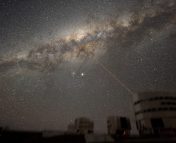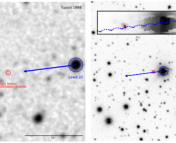
The undergrad research series is where we feature the research that you’re doing. If you’ve missed the previous installments, you can find them under the “Undergraduate Research” category here.
Are you doing an REU this summer? Were you working on an astro research project during this past school year? If you, too, have been working on a project that you want to share, we want to hear from you! Think you’re up to the challenge of describing your research carefully and clearly to a broad audience, in only one paragraph? Then send us a summary of it!
You can share what you’re doing by clicking here and using the form provided to submit a brief (fewer than 200 words) write-up of your work. The target audience is one familiar with astrophysics but not necessarily your specific subfield, so write clearly and try to avoid jargon. Feel free to also include either a visual regarding your research or else a photo of yourself.
We look forward to hearing from you!
************
Title: A Gravitational Redshift Measurement of the White Dwarf Mass-Radius Relation
Authors: Vedant Chandra1*, Hsiang-Chih Hwang1, Nadia L. Zakamska1, Sihao Cheng
First Author Institution: 1Department of Physics & Astronomy, Johns Hopkins University, Baltimore, MD, USA. *[email protected]
Accepted to the Astrophysical Journal (closed-access)
Open access on ArXiV

I’m a rising senior at Johns Hopkins University, majoring in Physics and Applied Mathematics with a minor in Space Sciences. Over the past two years I’ve conducted research characterizing white dwarf stars under the supervision of Professor Nadia Zakamska and graduate student Hsiang-Chih Hwang. I also work part-time at STScI, studying star formation in nearby galaxies. I spend a large portion of my free time staring at this photograph.
Background
From the moment they are born, stars are continuously evolving. The main source of energy of any star is hydrogen in its core, and once it runs out of that, it turns to helium. What happens after this fuel is spent up depends on the mass of the star, but for 97% of all stars in the Universe, the end-of-life phase is a white dwarf star. When a dying star expels its outer layers, it leaves behind a dense core around the size of the Earth, but with a mass around that of the Sun. Consequently, white dwarfs are unimaginably dense – one teaspoon of white dwarf matter can weigh up to 15 tons! Once formed, white dwarfs do not burn any fuel via nuclear fusion as they did when hydrogen or helium was their source of energy. Rather, they gradually cool over trillions of years via radiation, like a forgotten cup of hot coffee left in the vacuum of space. There is also strong evidence that white dwarfs in binary systems may be the elusive progenitors of type 1a supernovae.

The depths of a white dwarf are composed of a ‘degenerate’ electron gas, which is a complex state of matter that arises when particles are so densely packed together that quantum mechanical effects begin to change the way temperature, density, and pressure relate to one another. The push and pull between gravitational collapse and these quantum mechanical effects is encoded in the so-called ‘equation of state’ of the electron gas. One of the most curious properties of white dwarfs is the mass-radius relation – if you add matter to a white dwarf, its radius decreases and vice versa. This counter-intuitive phenomenon is a direct consequence of the equation of state of degenerate electrons, and its study contributed to S. Chandrasekhar’s 1983 Nobel prize in Physics.
The exact formation, composition, and evolution of white dwarfs has been the subject of intense theoretical work over the past half-century. However, observationally supporting these theories has always been challenging – due to their small size, white dwarfs are much fainter at a given distance than other stars. At the turn of the century in 1999, only about 2,000 white dwarfs were known. However, in the past decade alone, ambitious missions like the Sloan Digital Sky Survey (SDSS) and the Gaia Space Observatory have revealed and observed hundreds of thousands of white dwarfs in our galaxy.
Our Work
In our paper, we measure the white dwarf mass-radius relation by using observations from the Sloan Digital Sky Survey (SDSS) and the most recent data release from the Gaia space observatory.
We begin by measuring stellar radii for over 3000 white dwarfs. The observed brightness of a star depends on three things: the star’s temperature, radius and its distance from the Earth. To get at the temperature, we have atmospheric models for white dwarfs that predict how much light they emit at different wavelengths (their ‘spectral energy distribution‘ or SED) , which we can match to observed SEDs from SDSS. All stars in our sample have excellent distance measurements from Gaia using the trigonometric parallax method. We can therefore use our estimated stellar temperature from SEDs and distance measurements from Gaia to solve for the remaining variable, the radius of the white dwarf.
The second measurement we use is the gravitational redshift. Einstein’s theory of general relativity predicts that light originating from a massive body should redshift to longer wavelengths as they climb out of the body’s gravitational potential. This gravitational redshift depends on the ratio between the emitting star’s mass and radius, making it an excellent probe of the mass-radius relation. Observationally, this looks exactly like the Doppler shift of photons coming from a source moving away from us. We can measure this shift using spectroscopic observations from SDSS, comparing the observed wavelengths of hydrogen absorption lines to their theoretical wavelengths.
In theory, white dwarfs of a certain radius should have a fixed gravitational redshift as predicted by the mass-radius relation. However, measuring the gravitational redshift of an individual star is confounded by the fact that the star has an additional Doppler redshift caused by its random motion relative to us. Therefore, we instead average the observed apparent radial velocities of hundreds of white dwarfs with similar radii. Statistically, the Doppler shifts caused by their random motions in different directions should average to zero. The averaged measurement therefore uncovers the underlying average gravitational redshift for white dwarfs in a given range of radii.
By repeating this process for over a range of radii, we measure the average gravitational redshift binned as a function of stellar radius. Since the gravitational redshift depends on the ratio between mass and radius, and we have an independent measurement of the radius, we can now compute an empirical mass-radius relation (Figure 5 in the paper). Our measurement of the white dwarf mass-radius relation is highly consistent with current theoretical models.

Future
Measuring a theoretically consistent mass-radius relation is certainly reassuring, but the story doesn’t end there. One of the most heated topics in white dwarf physics is the composition of their cores – current evidence points to either oxygen-neon cores or carbon-oxygen cores, and each has a subtly different mass-radius relation. The uncertainties in our current measurements do not enable us to distinguish between the two possibilities and select a more favorable one.
However, upcoming large-scale surveys like SDSS-V will increase the sample size of white dwarfs by an order of magnitude, improving the averaged gravitational redshift measurement. Further, the upcoming third data release from Gaia will provide improved distance estimates to all stars in our sample, which translates to more accurate radius measurements. With these future observations of white dwarfs, especially at the high-mass end, it may be possible to constrain white dwarf core composition and other similar characteristics using the gravitational redshift method.




